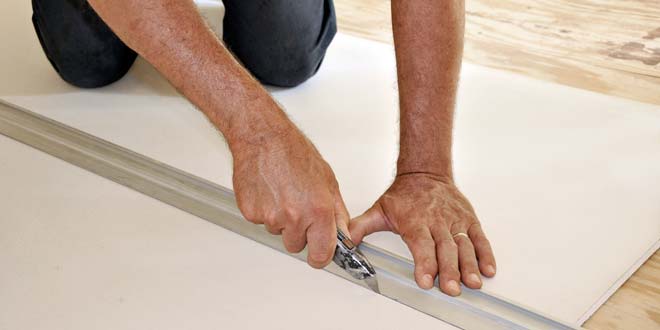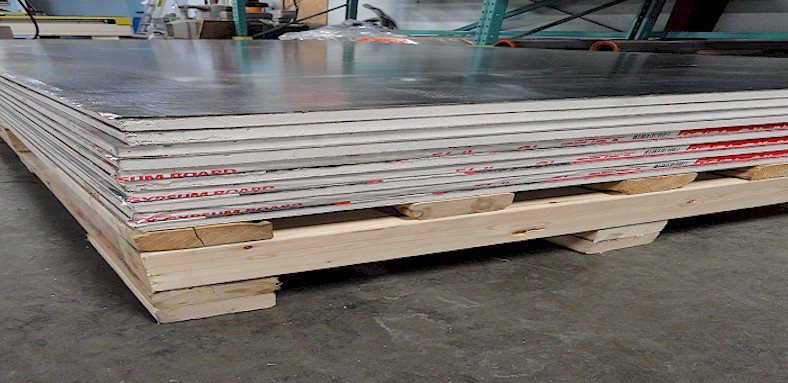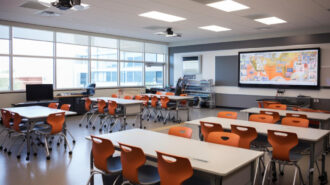Lead Lined Drywall & Lead Backed Sheetrock
Sheet lead backing must be equal or greater in value as the lead in the wall partition where penetration occurs
A sheet lead backing must be at least equal to the thickness of the lead in the wall partition where penetration occurs, or greater. This ensures continuity of protection. The lead sheet must be at least 1/16″ thick, and it must overlap all adjacent wall panels by at least one inch. Once the lead sheet is applied, it should be glued to the backside of the wall panel with a construction adhesive. In some cases, lead linings can have multiple layers, which should be staggered.
If there is a joint between two walls, the joint should be sealed to prevent air leakage. A knee wall is a common source of air leakage in houses. The ceiling joists below the knee wall should be sealed flush with the back of the knee wall finish. The ceiling joist opening can be sealed by using foam board or spray foam. Alternatively, loose-fill insulation can be installed between floorboards and the ceiling below. However, it is necessary to install an air barrier before installing the insulation. Additionally, it is advisable to install gable vents in the attic to prevent wind from blowing through the insulation.
For doors, the lead lining must be equal to or greater in value than the lead used in the wall partition where penetration occurs. In addition, doors must be aligned and level, with their hardware providing adequate shielding at penetrations and cutouts. Finally, the lead lining must be protected with paint or asphalt mastic.
Standard sizes of sheet lead backing for interior coatings are 1 inch (25 mm) by 4 inches (102 mm) by eight inches (204 mm) by two-1/2 inches (51mm) by 12 inches (305 mm). This is an excellent choice for an insulated gypsum board. Moreover, it has good durability and can improve the thermal performance of the walls.
MarMetal Lead-Lined Drywall
MarMetal Drywall is a type of lead-lined drywall that meets ASTM standards and Federal Specifications. Lead is a naturally occurring metal that is 99.9% pure and free from any oxide inclusions or dross. Lead-lined drywall is typically installed vertically. If required by local building codes, lead-lined drywall can also be installed horizontally. When using lead-lined drywall, fasten it on every 8″ on center at panel edges and every 12″ on center to intermediate framing members.
Lead lined drywall is designed to shield against radiation. It is a great choice for medical and industrial buildings. The material is backed with sheet lead, which acts as a shield against ionizing radiation. Lead-lined drywall is available in varying thicknesses depending on the level of radiation shielding required for the environment. To determine which thickness is right for your space, you can consult a licensed radiation physicist or your local health department.
Lead-lined drywall has lead added to the drywall panels for a fire-resistance barrier. Lead-lined drywall should conform to ASTM C36 and meet fire-code requirements.
It is available in 1/32″ to 1/8″ thick, with a minimum thickness of 5/8″. The drywall sheet is bonded to the lead sheet. Lead-lined drywall is available in various sizes, ranging from 4′ x 8′ to 4′ x 10′, with thicknesses between 5/8″.
However, it is not recommended to install lead-lined drywall on the interior of a home.
Lead-lined sheetrock comes in standard thicknesses of 5/8″ and 1/8″ and can be double-layered in high radiation applications. The thickness is also available in two-inch lead strips. Lead discs no longer need to be cut out for fastener penetrations. However, lead shielding products must still be used around electrical outlets and other receptacles. If you’re in need of a reliable, trustworthy drywall contractor in Sherwood Park who will fix damaged drywall in your home, contact us today.
Gypsum Wallboard for Soundproofing
Lead-lined drywall is a type of gypsum wallboard that offers significant soundproofing. It is also used for radiation shielding. Lead-lined drywall is made by gluing sheet lead to gypsum board. It is an excellent solution for buildings with high radiation exposure.
The global market for Lead Lined Drywall is projected to reach USD million by 2028. It is expected to grow at a CAGR of % over the next six years. This report also provides an in-depth analysis of the competitive landscape and the impact of major global and domestic players on the market. It also analyzes the growth potential and strategic market opportunities.
NELCO Defect Free Lead Lined Drywall
NELCO Lead Lined Drywall is made of high-quality, defect-free lead. It is available in different thicknesses and sizes. Experts at NELCO will be able to recommend the perfect thickness for your project. They can also help you determine the proper layout of your walls. NELCO also offers lead-lined plywood products that are used for filling gaps between lead-lined gypsum wallboard and lead brick. Moreover, these panels are fire-rated and are available from facilities all over the United States.
NELCO Lead Lined Drywall is a safe option for veterinary clinics and laboratories. Although many states do not require special lead drywall for veterinary hospitals, they have strict guidelines to protect employees, patients, and customers. Some even require special sheetrock for these areas. For example, in some states, it is not allowed to install radiography rooms back-to-back with the waiting area.
Lead lined drywall is a type of drywall that contains a lead core laminated to a standard drywall thickness. The material is then bonded together with a continuous layer of mastic adhesive. This type of drywall is typically installed vertically but may be installed horizontally when required by local building codes. The lead lining should be fastened to the drywall at 8″ centers on all edges and at 12″ centers on all intermediate studs. Then, two-inch-wide sheet lead strips should be installed at each joint stud with standard construction adhesive to provide a one-inch overlap.
Lead Lined Drywall for Radiation Shielding
The main purpose of lead lined drywall is radiation shielding. The material is an excellent shield against gamma, x-rays, and alpha rays. It does not, however, shield against thermal or fast neutrons. Lead lined drywall meets all applicable ICRP and NCRP lead shielding criteria.
Lead lined drywall is often used in medical and industrial buildings. It is also known as lead-lined sheetrock or lead wallboard. Lead lined drywall has a lead sheet backing, which provides a barrier to radiation. Lead backed drywall is available in various thicknesses. Check with the health department or radiation physicist in your area to see which thickness is right for your space.
Lead lined sheetrock is typically installed vertically and cannot be installed horizontally. Each joint must have a lead batten strip on it to provide radiation shielding overlap. Two-inch-wide lead strips are typically used to cover all seams and intermediate studs. Fasteners should be spaced at least eight inches apart for NCRP compliance, while intermediate studs and drywall should be spaced at twelve inches.
Other considerations
If you are planning to install lead lined drywall, you need to know some important considerations. First of all, make sure the walls are supported by heavy-gauge metal studs. Then, fasten the panels to the studs on an 8-inch-to-12-inch center line using standard construction adhesive. You should also fasten the drywall to the ceiling and to any intermediate framing members.
Secondly, lead lined drywall is a good shield for ionizing radiation. It is used in industrial buildings and medical facilities where radiation is a major concern. Lead lined drywall is made by laminating a sheet of lead to drywall. This type of drywall is also known as lead wallboard and lead sheetrock.
Lead lined sheetrock is available in standard sizes and can be custom-cut. It can also be retrofitted into existing buildings. Lead lined sheetrock should last for many years, so it is a good investment. To ensure its longevity, buy premium-quality sheetrock. It is available in different thicknesses and types.
Besides fire-rated and non-fire-rated options, lead lined gypsum board is available in varying thicknesses. You can even purchase lead batten strips to shield seams and lead discs and tabs to cover drywall screws. Lead lined gypsum wallboard can also be used for radiation protection.



















